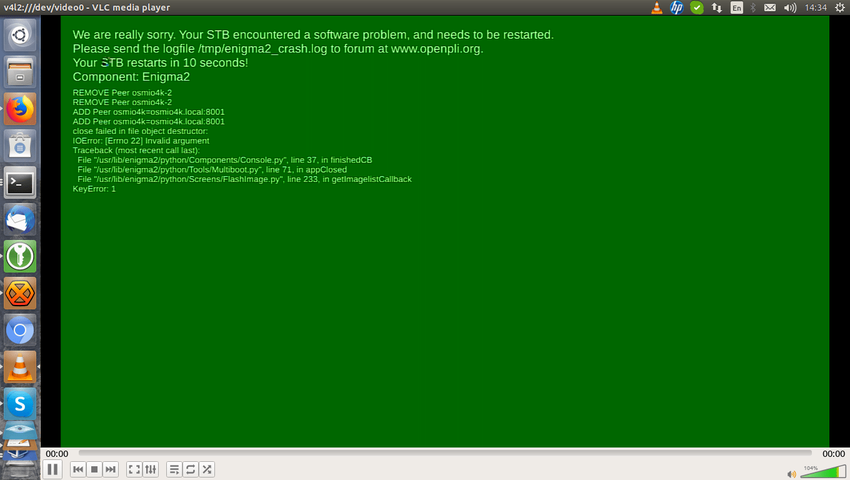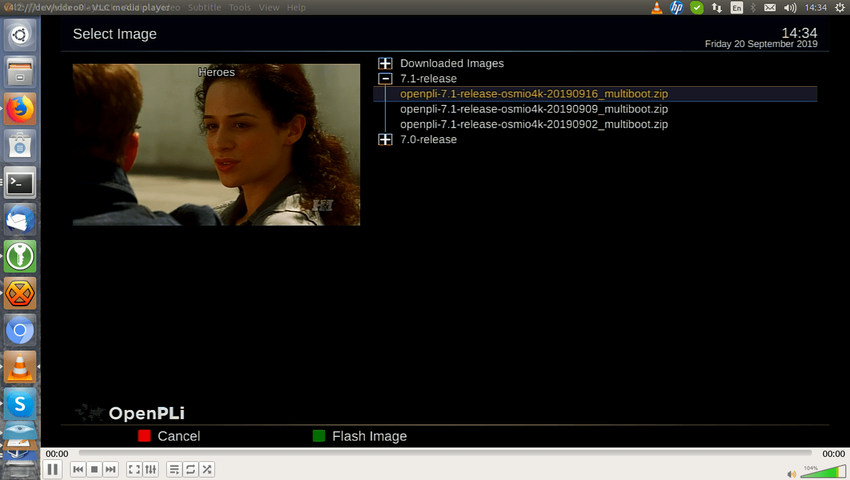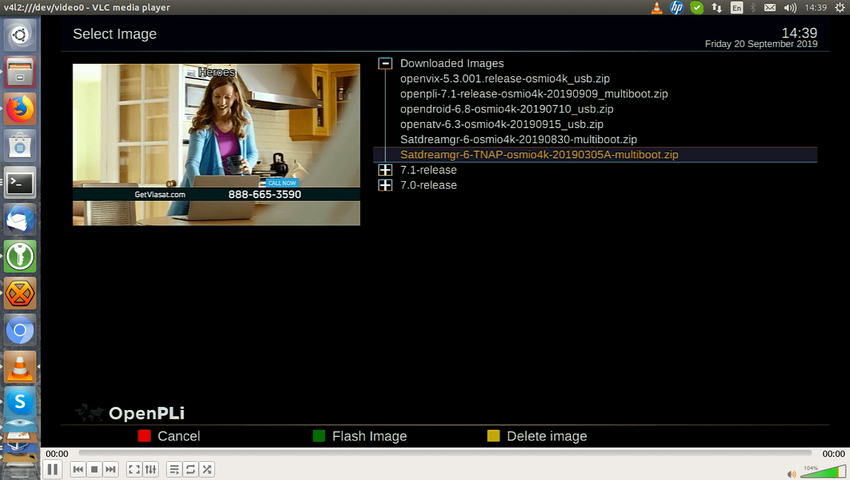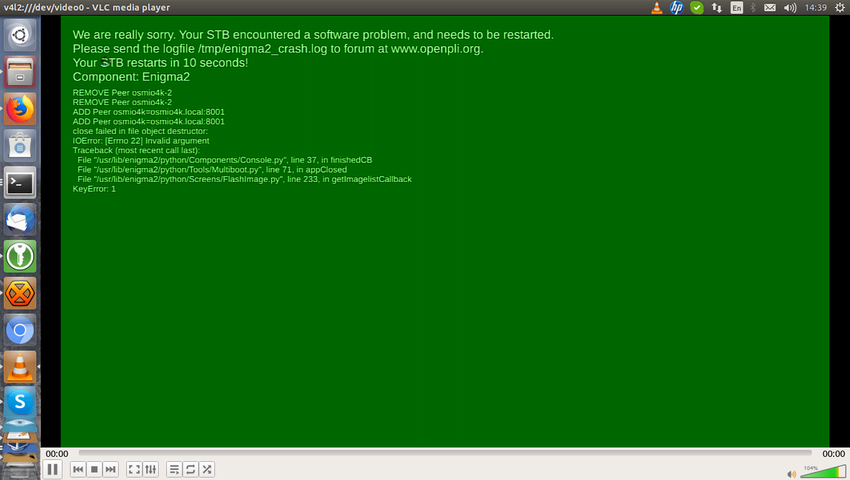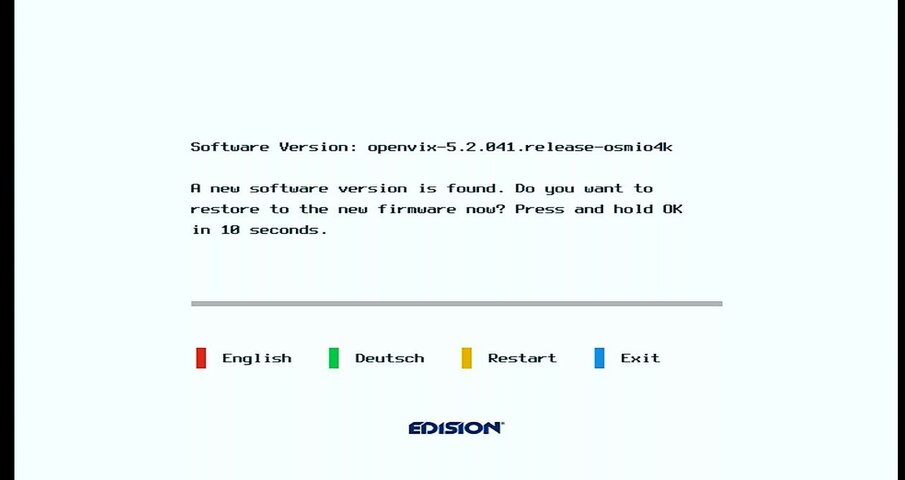Is the TNAP project dead?No, TNAP does NOT provide updates....
Latest osmio4k issues
- Thread starter WhiteBeard
- Start date
- Latest activity Latest activity:
- Replies 132
- Views 17K
You are using an out of date browser. It may not display this or other websites correctly.
You should upgrade or use an alternative browser.
You should upgrade or use an alternative browser.
You may recall from earlier thread discussions, no automatic updates were ever planned for The North American Project. TNAP is intended to be an introduction or used as a standard Enigma2 image for first-time or appliance STB type users.
With the upcoming OS Mio+ model introduction, another TNAP version has been in development and will soon be released for manual loading (not automatic update) on the OS Mio.
The primary goal for TNAP is to provide a solid and fully tested E2 experience and blind scan optimization for North American hobbyists rather than provide the latest E2 feature developments; which as open source, potentially (and historically) introduces buggy operation.
The user may use the other 3 multi-boot image slots in the OS Mio and Mio+ to run alternative images of their choosing. Some users prefer solid predictable operation, while others desire cutting edge technology and are willing to accept the risks associated with new features or with nightly or weekly auto or manual updates.
With the upcoming OS Mio+ model introduction, another TNAP version has been in development and will soon be released for manual loading (not automatic update) on the OS Mio.
The primary goal for TNAP is to provide a solid and fully tested E2 experience and blind scan optimization for North American hobbyists rather than provide the latest E2 feature developments; which as open source, potentially (and historically) introduces buggy operation.
The user may use the other 3 multi-boot image slots in the OS Mio and Mio+ to run alternative images of their choosing. Some users prefer solid predictable operation, while others desire cutting edge technology and are willing to accept the risks associated with new features or with nightly or weekly auto or manual updates.
Thanks for the explanation. I didn't read the entire thread -- I understand now.You may recall from earlier thread discussions, no automatic updates were ever planned for The North American Project. TNAP is intended to be an introduction or used as a standard Enigma2 image for first-time or appliance STB type users.
With the upcoming OS Mio+ model introduction, another TNAP version has been in development and will soon be released for manual loading (not automatic update) on the OS Mio.
The primary goal for TNAP is to provide a solid and fully tested E2 experience and blind scan optimization for North American hobbyists rather than provide the latest E2 feature developments; which as open source, potentially (and historically) introduces buggy operation.
The user may use the other 3 multi-boot image slots in the OS Mio and Mio+ to run alternative images of their choosing. Some users prefer solid predictable operation, while others desire cutting edge technology and are willing to accept the risks associated with new features or with nightly or weekly auto or manual updates.
It seems to me that it might be good to either make TNAP 'read only', or disable the 'Update' menu option. Would avoid confusion like the OP experienced. But I don't have a Mio, so maybe there are good reasons to leave it like it is now.
Last edited:
My box crashed when attempting to install that image. Here is the log: Ubuntu Pastebin
Slot 1 firmware was deleted, by the way. OpenPLi is in slot 3.
Slot 1 firmware was deleted, by the way. OpenPLi is in slot 3.
No, starting in post #1 and repeated in other replies throughout this thread, you have indicated that the image was The North American Project.
E2 images are not the same and will provide different experiences on the STB. These details are important! We all have been wasting time if not comparing apples to apples.
Will provide the TNAP image via Dropbox in a few hours....
It booted with the TNAP splash screen so that's why I said it's TNAP.
I'm trying to make sense of what this box is doing. After my last flash attempt, I rebooted to OpenATV. Then I rebooted again and the box reinstalled OpenVIX to slot 1 when I didn't request it to do so. Not to mention that I uninstalled OpenVIX a couple of days ago. After the reboot I ended up in OpenVIX. Then when I requested a reboot to slot 3 (OpenPLi) I got the impression that it actually booted to slot 1. But, that makes no sense because it shows up as OpenPLi when OpenVIX is (?) in slot 1. Anyway, I was guessing that when I mentioned that slot 1 disappeared that I figured that I was booted to the image in slot 1 and that's why it didn't show up in the multiboot menu. Then I figured that I was trying to install TNAP into slot 1 when it was in current use and that's why I got a crash message. I suppose if I take more time I can present these issues in a more logical fashion. The bottom line is that everytime I try to install TNAP the box crashes.
Attachments
A backup of OpenVIX (stored in the Edision OS Mio) wrote back to the deleted slot 1 when the error occured.There is a good SatelliteGuys thread on the multiboot management differences for OE and PLi based images. Sorry, I don't have good forum search capabilities on this platform.
The TNAP file that I provided should automatically install when powering ON the STB with the folder on root level of the USB thumbdrive if the folder includes a "force" file.
If not, rename the TNAP "force" file to "noforce" then place the TNAP in a folder named downloaded_images on root level and install in slot #1 while running the OpenPLi image in a different slot.
May need to use telnet (PuTTy or favorite software) to delete the images from the slots then install the TNAP image. The Mio telnet user info and commands to clear and run the install package are covered in a few threads here on Satelliteguys, but covered in detail on the legitFTA website.
I am out the office and away from the satellite gear for a few days. Will be available to assist again on Monday.
The TNAP file that I provided should automatically install when powering ON the STB with the folder on root level of the USB thumbdrive if the folder includes a "force" file.
If not, rename the TNAP "force" file to "noforce" then place the TNAP in a folder named downloaded_images on root level and install in slot #1 while running the OpenPLi image in a different slot.
May need to use telnet (PuTTy or favorite software) to delete the images from the slots then install the TNAP image. The Mio telnet user info and commands to clear and run the install package are covered in a few threads here on Satelliteguys, but covered in detail on the legitFTA website.
I am out the office and away from the satellite gear for a few days. Will be available to assist again on Monday.
Last edited:
Here is another issue I'd like to resolve. After uninstalling OpenVIX, I still get a display prompting me to install the latest OpenVIX image after EVERY reboot. What can I do to fix this? The attachments show screen displays when I reboot any firmware image. I have the "The North American Project" (SatDreamGr) in slot 1, OpenDroid in slot 2, OpenPLi in slot 3, and OpenATV in slot 4.
Attachments
I got TNAP re-installed. Took a couple of hours to get it done. Went in circles a few times. But it's done. Time for a break.
Attachments
-
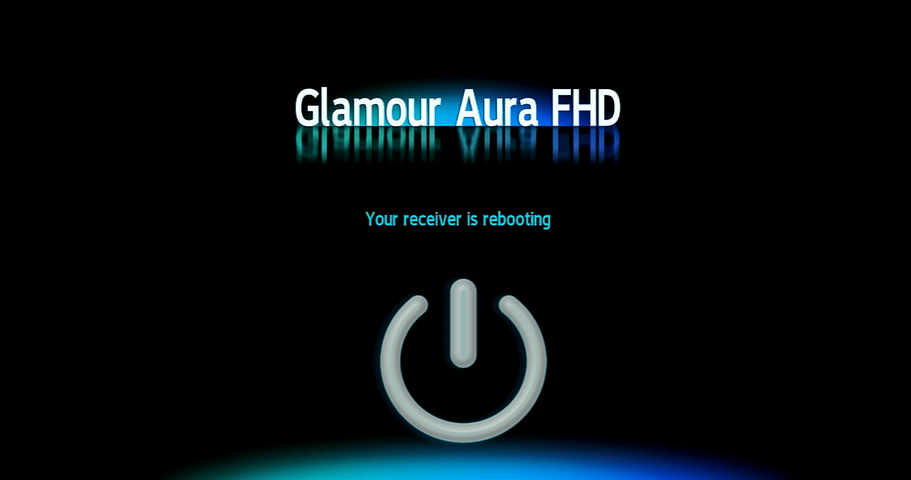 Screenshot from 2019-09-21 11-19-02.png52.1 KB · Views: 214
Screenshot from 2019-09-21 11-19-02.png52.1 KB · Views: 214 -
 Screenshot from 2019-09-21 11-19-36.png222.9 KB · Views: 217
Screenshot from 2019-09-21 11-19-36.png222.9 KB · Views: 217 -
 Screenshot from 2019-09-21 11-19-42.png224.4 KB · Views: 213
Screenshot from 2019-09-21 11-19-42.png224.4 KB · Views: 213 -
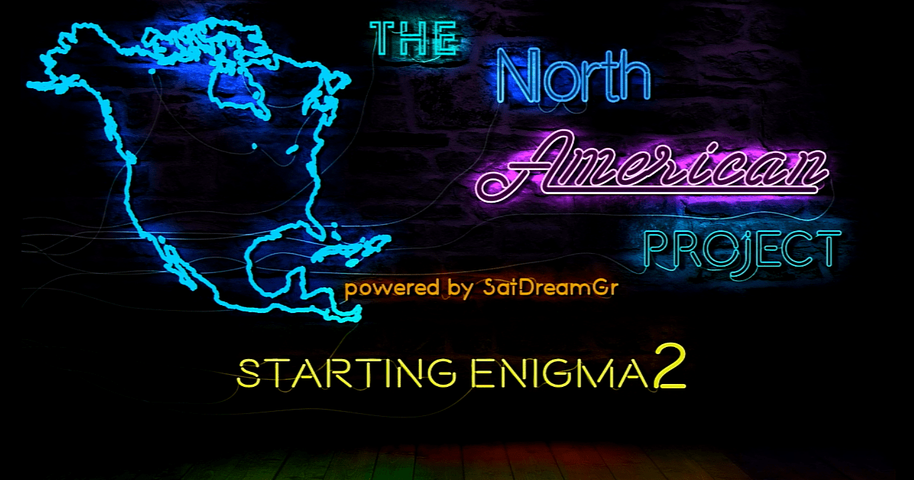 Screenshot from 2019-09-21 11-19-50.png233 KB · Views: 228
Screenshot from 2019-09-21 11-19-50.png233 KB · Views: 228 -
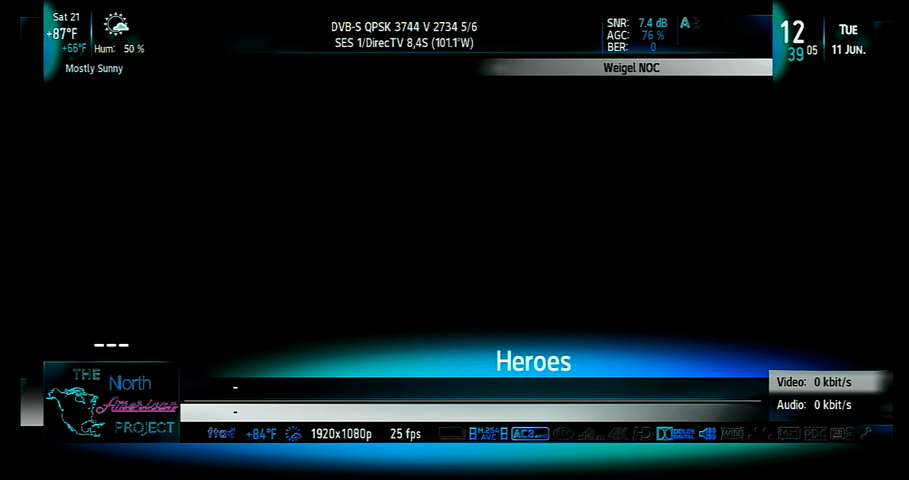 Screenshot from 2019-09-21 11-19-59.png82.7 KB · Views: 195
Screenshot from 2019-09-21 11-19-59.png82.7 KB · Views: 195
To get rid of the OpenVIX bootlogo and version check, it will be best to delete ALL slots and install SatDreamGR to slot 1 via telnet. The SatDreamGR package contains the Edision bootloader will overwrite the OpenVIX bootlogo and version check. Once SatDreamGR has booted, complete the set-up menu (exiting after setting resolution) then use the image install multiboot menu to load TNAP image from a folder named "downloaded_images" located on the root level of a USB drive.
If you wish to install OpenVIX to slot 1, 2 or 3, remove the boot image file from the OpenVIX image file (if there is a "force" file, rename to "noforce") then place the folder in the "downloaded_images" folder on the USB and install from the TNAP image multiboot menu.
If you wish to install OpenVIX to slot 1, 2 or 3, remove the boot image file from the OpenVIX image file (if there is a "force" file, rename to "noforce") then place the folder in the "downloaded_images" folder on the USB and install from the TNAP image multiboot menu.
For some reason I can't find the telnet procedure for adding and deleting images from the CLI. I found it months ago but didn't bookmark it.
I'll locate and post on Monday. I had posted El Bandido's telnet info from the Legitfta site to a thread here on SatelliteGuys a few months ago, but only on a smartphone this weekend, so hard to search.
I'll locate and post on Monday. I had posted El Bandido's telnet info from the Legitfta site to a thread here on SatelliteGuys a few months ago, but only on a smartphone this weekend, so hard to search.
Found it and bookmarked it and exported bookmarks to other PC's. I just hope that I remember that I bookmarked it. Anyway, I managed to get rid of the OpenVIX splash screen.
I just discovered that when I reboot TNAP, the time zone setting is lost. I did click on save. There is the issue of slot 1 not coming up in the OpenPLi multiboot menu, also. So, I tried wiping out all the slots again to start over. But, I must have messed up something because no image gets loaded and I can't telnet into the box and the front panel of the mio is stuck at "boot'. I can't bring up the multiboot menu using the remote's menu key either.
I got an image loaded but it seems that an emmc.img file is required in order to boot from the USB stick but one doesn't come with OpenPLi or SatDreamGr or TNAP. The file does come with OpenVIX, OpenDroid and OpenATV.
Yes the emmc.img is for loading with usb flash drive in slot 1.The multiboot files from openpli ,satdreamgr and TNAP need to be loaded with downloaded_images folder on the flash drive or hard drive. If doing multiboot don't flash emmc in slot 2,3 or 4 use flash image menu in TNAP,openpli and satdreamgr.I got an image loaded but it seems that an emmc.img file is required in order to boot from the USB stick but one doesn't come with OpenPLi or SatDreamGr or TNAP. The file does come with OpenVIX, OpenDroid and OpenATV.
Yes the emmc.img is for loading with usb flash drive in slot 1.The multiboot files from openpli ,satdreamgr and TNAP need to be loaded with downloaded_images folder on the flash drive or hard drive. If doing multiboot don't flash emmc in slot 2,3 or 4 use flash image menu in TNAP,openpli and satdreamgr.
So, do I have to install a non-multiboot image in slot 1 using emmc.bin on a thumb drive? I don't see how a multi-boot image like TNAP can be installed without an image already installed in the osmio or without an emmc.bin file. I wiped all the slots but couldn't install a multi-boot image from the thumb drive or with telnet without first installing one of the non-multiboot images. Makes sense since after wiping all the slots there's no OS in order to install the multiboot images. The idea was to get a clean install to start from. By the way, all of the multiboot images were put into the downloaded_images folder.
Yes a non multiboot to get it going and a multiboot image can be flashed to slot1. Say you flashed non multiboot openpli 7.0r emmc in slot1 now you can use the flash image menu and put TNAP in downloaded_images folder and flash TNAP slot1.
Set your Time settings like this. This screen is from NA SDGr, but it's similar in other images.
RTC time, and NTP Cold Start need to be turned ON.
I did that. The OpenVIX time still jumps around. Even after wiping all firmware and then re-installing it. OpenVIX is the only image that does this (so far).
Maybe something has broken in recent OpenVIX releases? For my daily viewing STB, I don't typically use OpenVIX so don't update. Have version 5.2.034 with kernel 5.0.0 and the VIX-Night-HD skin loaded in slot 3 with no NTP time issues. Here is my time screen setting in OpenVIX. Anyone one else use OpenVIX?
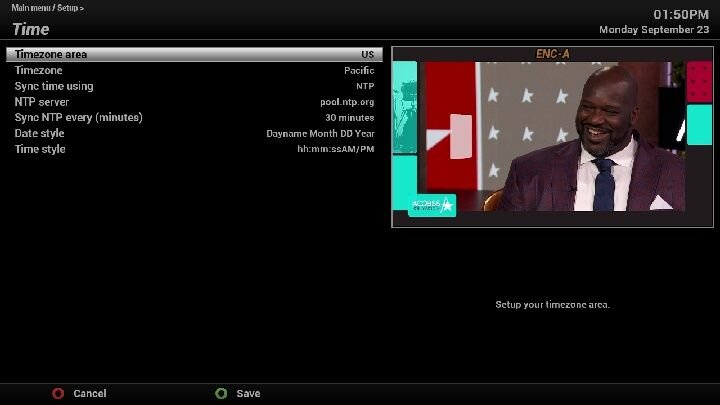
If the problem continues, consider joining the OpenVIX forum and see if any other users are experiencing NTP time reference problems.

If the problem continues, consider joining the OpenVIX forum and see if any other users are experiencing NTP time reference problems.
Last edited:
Similar threads
- Replies
- 30
- Views
- 6K
- Replies
- 27
- Views
- 3K
- Replies
- 8
- Views
- 2K
- Replies
- 12
- Views
- 2K
- Replies
- 15
- Views
- 3K


